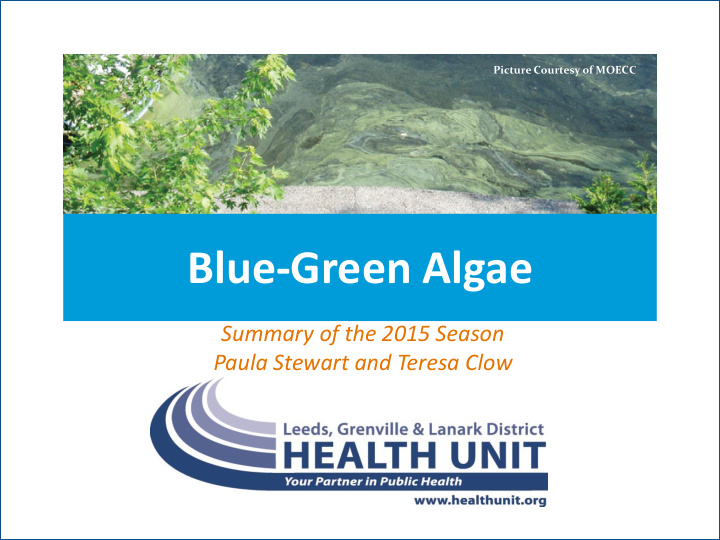



Picture Courtesy of MOECC Blue-Green Algae What To Do When Your Lake is Affected Summary of the 2015 Season Paula Stewart and Teresa Clow
Responding to Blue -Green Algae Incidents In 2015 the Health Unit and area Lake Associations launched a collaborative effort on blue green algae Information for lakes users on potential health risks by blue- green algae blooms and how to respond. Notification of blooms in a timely manner to lake users. April 2015 presentation to Lake Networking Group by various agencies involved with blue-green algae Lake Networking Group compiled an extensive list of Lake Associations and their contacts and email addresses and provided to it to the health unit. Resources such as fact sheets and a PowerPoint presentation were made available to Lake Associations
Response to Reports of Suspected Blue Green Algae Resident reports of blue-green algae were directed to Spills Action Centre (SAC) SAC notified the Ministry of Environment and Climate Change (MOECC) area Environmental Officer Environmental Officer reviewed photos if provided or and/or conduct site visit to confirm and collect samples Health Unit notified by MOECC, and where visual confirmation was made, a notice was sent out to the contacts on the Lake Association list for distribution Copy of notice was also sent to township, and conservation authority as an FYI
Sample Results When sample results were provided to the Health Unit, another notice was sent to the same groups indicating if toxin was present or not and at what levels All notices were posted on the Health Unit website
Sample Notice to Lake Associations
Sample Notices re Toxin Results
Getting the Message Out This summer a student distributed this poster to: • local marinas • posted it at boat launches To educate visitors to our lakes regarding blue-green algae A table top version of blue-green algae display is available to lake associations upon request
Focus of Messaging Key Messages Include: Being able to recognize blue-green algae blooms and taking a cautionary approach rather than waiting for results of testing Knowing what precautions need to be taken regarding drinking water, swimming and recreational activities, and fishing Assessing conditions in their area of the lake to determine when they can resume their activities
Reports of Blue-Green Algae Blooms The health unit responded to 16 reports of blue-green algae Highest number of reports in recent years Earliest report received in June, reports continued into late September, early Ocober. Number of Number Number Number Reported Confirmed as Confirmed as Containing Sightings BGA not BGA Toxins 16 7 9 3
What Our Residents Shared With Us
In Conclusion The Health Unit would like to express their sincere thanks to Lake Association partners for all their assistance in getting the message out. We hope to continue to work together and improve the system. We are open to your suggestions, so please feel free to put forth ideas for our consideration.
Know the Plant Know the sap Know what to do
Know the plant: wild parsnip Found in disturbed areas Most commonly fund in railway embankments, roadsides, trials, shorelines, ditches, forest clearings, quarries Ontario – along fence rows, edge of agricultural fields, water courses and drainage areas Can invade agricultural fields
Know the plant: wild parsnip Grows for two years then flowers and produces a fruit containing thousands of seeds then dies Seeds mature by mid-summer Remain attached to dead stock with seed dispersal between August and November
Know the plant: wild parsnip Seeds can remain in soil for 5 years. Reproduce by seeds, majority germinate in the spring, plants found grow year after year to same place Animals may bring sap from plant into contact with people.
Know the sap Sap on stem, leaves and flowers contains furocoumarins. Furocoumarins are absorbed by skin Sap most potent when plant is in flower Moisture form perspiration speeds absorption
Know the sap Sunlight (UV radiation) interacts with furocoumarins under skin Purplish skin discolouration Red painful rash within one day Inflammation and blisters to Photo credit: Andrew Link, Winona Daily News, 2013 skin within 3 days Risk of long lasting scars, temporary or permanent blindness
Know What to Do If skin is exposed to sap wash area with soap and water as soon as possible Protect area from sun exposure Watch for symptoms Cover area with a cool wet cloth and keep covered when in sun. Seek medical care if blisters form, do not burst them
Know What to Do Control of wild parsnip Mowing over repeated seasons (May – June) Removal by shovel Gloves, pants and long sleeve shirt and in evening Tarping Chemical control From: Wild Parsnip – Best Management Practices in Ontario (Ontario Invasive Plant Council)
Know What to Do
1-800 800-660 660-5853 5853 @LGLbeaches – June – Sept @areyousafe
Thank You
Recommend
More recommend